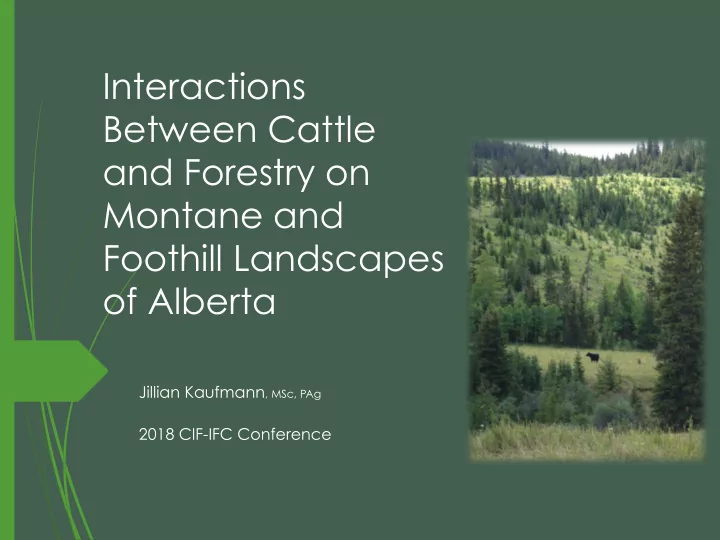

Interactions Between Cattle and Forestry on Montane and Foothill Landscapes of Alberta Jillian Kaufmann , MSc, PAg 2018 CIF-IFC Conference
Outline ´ Background ´ Research Objectives ´ Study Design ´ Results and Discussion ´ Management Implications
Background ´ Alberta forested public lands simultaneously support livestock grazing and forestry operations ´ Potential integration challenges: ´ Damage to young trees ´ Regeneration failure ´ Altered forage composition, production and accessibility ´ Grazing system interruption ´ Loss in profits
Background – Study Purpose ´ Facilitate successful integration of grazing and forestry on public lands ´ Contribute to development of best management practices ´ Partners ´ Rocky Mountain Forest Range Association ´ Alberta Sustainable Resource Development (now AEP) ´ University of Alberta ´ Alberta Beef Producers ´ Weyerhaeuser ´ Spray Lakes Sawmill ´ West Central Forage Association ´ Forest Resource Improvement Association of Alberta
Research Objectives ´ Observe cattle use of landscapes containing recently harvested cut blocks ´ Habitat preference ´ Foraging behavior ´ Influence of cattle stocking rate ´ Quantify cattle induced damage to young trees
Lower Foothills Study Site ´ Grazing lease near Logdepole, Alberta ´ Primarily deciduous – aspen, balsam poplar, paper birch ´ Timber harvested by Weyerhaeuser in January 2006 ´ Primarily natural regeneration with white spruce planting on haul roads ´ Four paddocks (each 2.5 – 3 ha) constructed containing areas of clear cut, partial harvest, haul road, uncut forest and brush piles ´ Grazing exclosures (0.2 ha) established within paddocks ´ Cattle grazed at low (0.3 AUM/ha) and high (0.6 AUM/ha) stocking rates
Montane Study Site ´ Rocky Mountain Forest Reserve grazing allotment near Maycroft ´ Three large pastures ranging 365 to 1035 ha ´ Six major habitat types: ´ Coniferous forest ´ Deciduous forest ´ Mixed wood forest ´ Native upland grassland ´ Modified lowland grasslands ´ Coniferous cut blocks harvested in winter 2005/2006 by Spray Lakes Sawmill ´ Cut blocks planted to lodgepole pine or white spruce ´ Herd of 320 cattle grazed pastures July through September 2008 & 2009 ´ Cattle stocking rate ranged from 0.4 to 0.6 AUM/ha ´ Cattle exclusion cages (1.5 x 1.5 m) set up in each habitat type
Data Collection ´ Cattle fitted with GPS collars to track location every 5 to 10 minutes ´ Network of circular 10 m 2 plots established throughout pastures ´ Foothills site - total of 233 permanent plots 10 to 30 m apart throughout all habitat types ´ Montane site – total of 210 plots distributed throughout habitat types ´ Plot data collected following grazing ´ Data parameters: ´ Cattle occupancy ´ Forage biomass, utilization and quality ´ Slope, aspect, elevation, canopy cover ´ Distance to roads and water ´ Slash cover, maximum height and distance to nearest grazing patch ´ Tree regeneration counts, maximum height and diameter, tree impedance rating and record of cattle induced damage ´ Plots established within grazing exclosures at the Foothills site to compare tree regeneration and growth
Data Analysis ´ GPS collar data cleaned and overlain on spatial maps of habitat types ´ Cattle locations used to calculate habitat preference using an electivity index ´ Plot data used to link evidence of cattle presence to environmental characteristics ´ Assessment of tree regeneration success and cattle induced impacts
Results – Cattle Habitat Preference Foothills Site
Results – Cattle Habitat Use Foothills Site
Results – Drivers of Forage Use Foothills Site ´ Cattle foraging behavior was influenced primarily by forage biomass and distance to water ´ Forage protein, slash cover and sapling density had a relatively small influence on cattle foraging behavior ´ Forage use was positively associated with greater forage biomass and better quality, and negatively associated with greater distance to water, slash cover and sapling density
Results – Tree Regeneration and Damage Foothills Site
Results – Sapling Damage Foothills Site
Results – Cattle Habitat Preference Montane Site
Results – Cattle Habitat Use Montane Site
Results – Drivers of Habitat Use Montane Site ´ At the local patch scale: ´ Cattle foraging behavior was influenced primarily by forage biomass ´ Distance to water and roads, forage quality, slope and aspect had a relatively small influence on cattle foraging behavior ´ Forage use was positively associated with greater forage biomass and quality and distance to roads ´ Forage use was negatively associated with greater distance to water, slope and aspect (representing less forage use on north-facing slopes) ´ At the larger landscape scale: ´ Slope, distance to water and distance to roads were the main parameters influencing cattle selection ´ Specifically within cut blocks, topography (primarily elevation) had the greatest influence on cattle presence ´ Forage quality played a greater role in regulating cattle presence within cut blocks than forage biomass ´ Distance to water was also a key factor explaining cattle use of cut blocks
Results – Cattle Use of Cut Blocks Montane Site
Results – Tree Regeneration and Damage Montane Site
Conclusions and Management Implications ´ Application of cattle stocking rates mandated by AEP promote successful integration of grazing and forestry ´ Cattle are unlikely to spend much time in recently harvested cut blocks provided they have access to more preferred habitats ´ Understanding cattle foraging behavior is imperative to preventing negative impacts ´ Timing of grazing needs to be considered – a single mid summer grazing allows time for stem lignification and improved strength ´ Forestry and cattle grazing were found to be compatible land uses in this study based on sustainable management ´ Provincial regeneration standards were met or surpassed for the most part. Regeneration inadequacies were not associated with cattle activity
Questions?
Recommend
More recommend